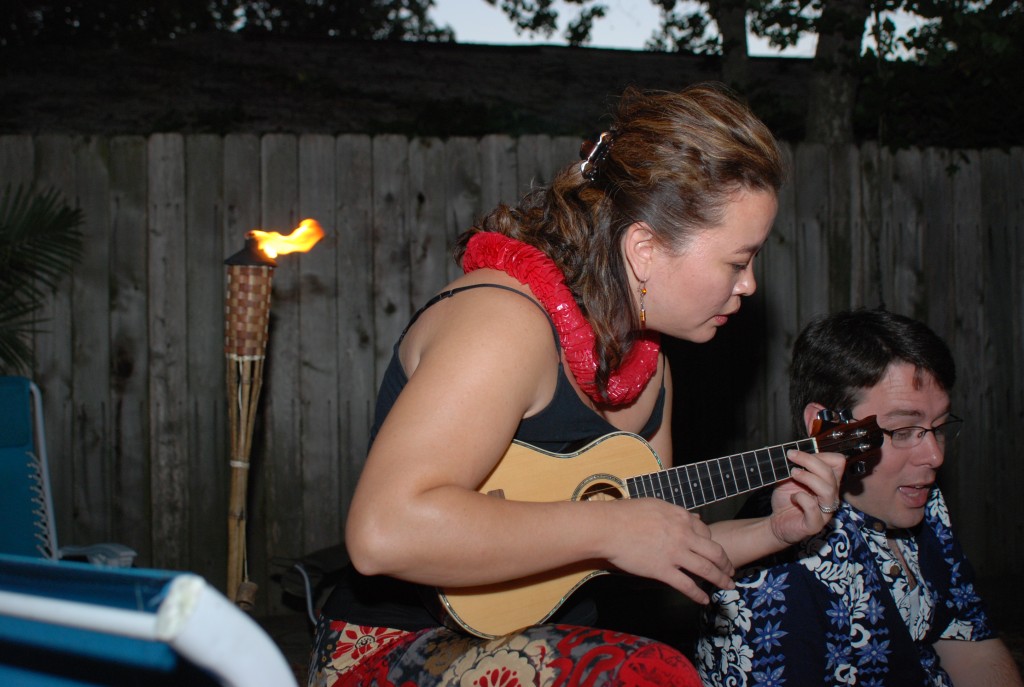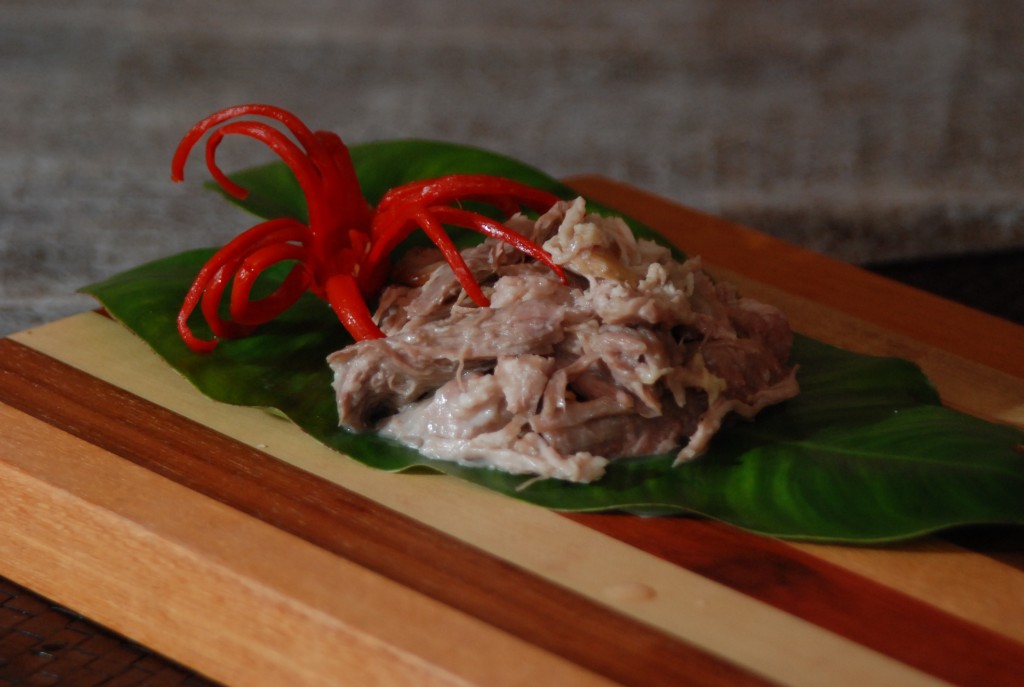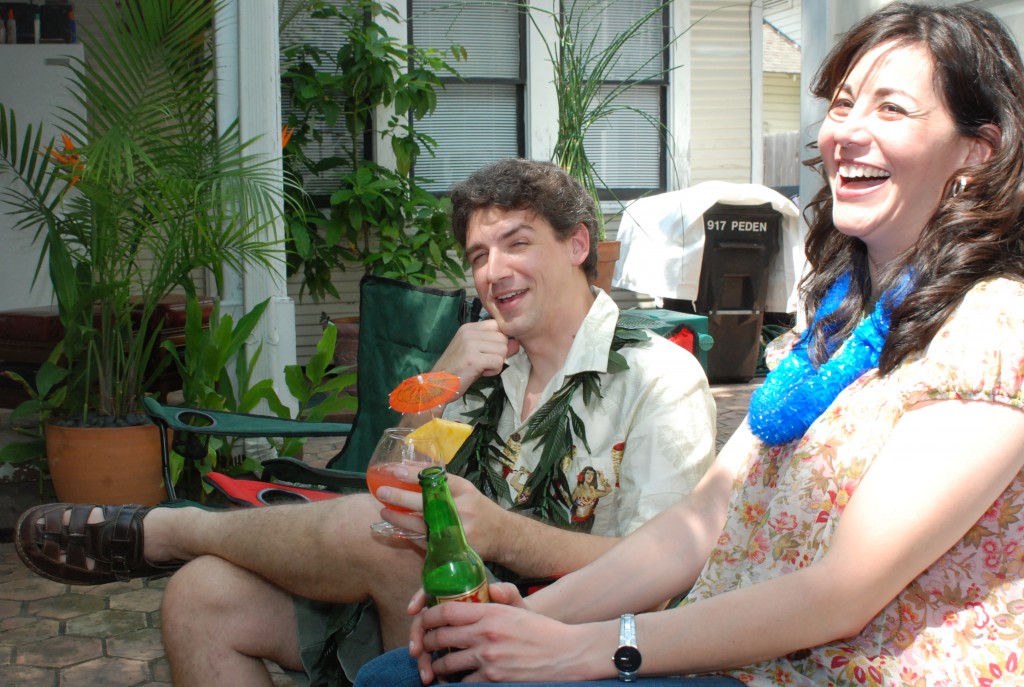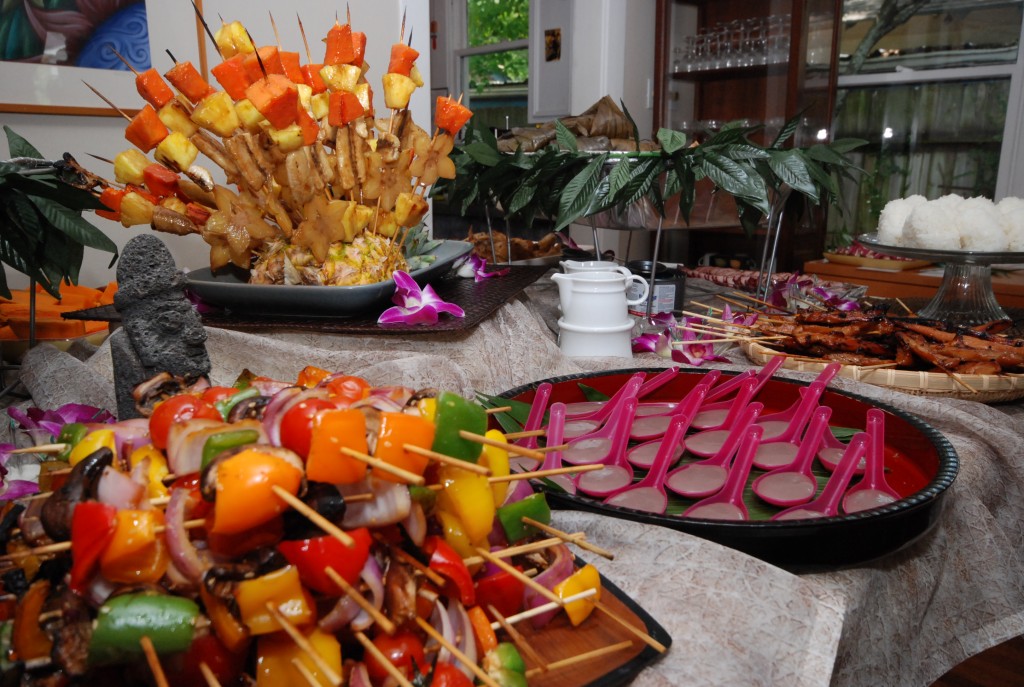Luau Know-How: Bringing a Taste of Hawaii to a Life in Montrose

JoAnn Takasaki has lived in Montrose longer than she’s lived anywhere else on earth. But while she treasures the friends, haunts, and habits she’s had since her first weeks here, when Takasaki entertains, it’s in the tradition of an earlier home: Hawaii.
The daughter of civil servants, Takasaki moved often during her childhood. Every summer, though, her family returned to Honolulu, where her father had grown up. For Takasaki, those plumeria-scented summers were the definition of home. Wherever they landed for their next posting, her parents recreated that feeling by gathering Hawaiian expatriates and throwing a luau.
In her brightly photographed, self-published book Luau Like A Local: The Easy Way, Takasaki, 45, recalls those times and shows how she has adapted the cuisine of a South Pacific culture to life in a bayou metropolis. Sometimes it’s dinner with one comfort food such as ahi poke – fresh tuna chopped into cubes, flecked with sesame oil, and dusted with crumbled seaweed, salt, and red pepper.
But occasionally Takasaki goes all out and throws a luau: a weekend-long feast where guests “talk story,” drink beer, and eat plate after plate of delectable, slow-cooked pig.
“Luaus,” Takasaki explains, “are usually community affairs. Everyone pitches in – from bringing a dish to digging an imu [cooking pit] to entertaining with ukuleles and hula to washing dishes.”
In Houston, she concedes, that communal know-how is hard to find. But because luau dishes are adaptable, one person can make them for eight or ten friends and still savor the luau’s traditional tastes and sociability.
That, Takasaki says, is how she brings a bit of Hawaii to Montrose.

Why did you write this book?
Much as it is for most ethnic groups, food is a central part of our internal family unit, as well as the community. Food for us is home: It’s comfort. When we are together we have breakfast, we talk about what we are going to have for lunch, we grocery shop, we talk about what we’re having for dinner.
The Hawaiian food in my book is the food I grew up with. This was originally a way for me to organize some of my mother’s recipes, which are also my grandmother’s recipes, for my family. It took eight years, because life happens – and because it took awhile to do all the measurements. My mother doesn’t measure anything.
What dish of hers is in heaviest rotation in your kitchen in Houston?
Poke. I just made myself some poke with avocado and rice this week. I ate it for dinner. Then I ate it for breakfast. There usually aren’t leftovers! It’s pretty simple. You cube up your tuna, add salt, chili pepper, sesame oil. Mix it all together.
Do you throw luaus routinely?
God no. It’s so much work. I’ve done three full luaus in Houston: for my 29th birthday, my 33rd birthday, and the book. But I do it all alone – I’m the only one of my friends who knows how to make the dishes, and in the kitchen I don’t play well with others. It’s entirely against Hawaiian tradition. Now that I have this book, my friends can make the dishes themselves and we can do a true luau. We can potluck it.

Are the recipes here different from those in a traditional luau?
This book is all about adaptation. A traditional luau with a whole pig serves five to six dozen people. The recipes in my book are sized for eight. The ingredients are mostly easy to get here, because there are so many ethnic communities who use similar things. I couldn’t find ti leaves, though, so I used banana leaves or spinach instead.
I ended up at Fiesta on North Shepherd for most of what I needed. I got the sesame oil at Kroger. And the tuna for the poke came from Whole Foods.
What are the most accessible Hawaiian dishes for novices?
You can’t go wrong with the pig. If you’re a pescatarian, there’s lomi salmon and poke. There’s not that much indigenous Hawaiian cuisine: the Polynesians rowed in catamarans, with a few woman and a couple of pigs, across a giant, giant ocean to a remote island made of lava. So you ate what was available, and a lot of it was meat and fish. I do have a recipe for a grilled veggie kabob with a sesame-based marinade and a Japanese cucumber salad called namasu in the book, but luaus are really a meat fest.
Have non-Hawaiian readers been using the book?
This guy in Colorado was the first to post photos from his luau. He did his own thing: he pressure-cooked the pork instead of roasting it in leaves. When you use a pressure cooker, you need to use liquid, so he used beer. It seemed to work great! Another woman found the book’s Facebook page and decided to make the coconut jello. She made it for 400 people for a church function. And a third woman, whose parents are from Hawaii, uses the book to make the dishes for them. She’s never been. She says they’re so happy each time she cooks.
Hawaiian and Tex-Mex work very well together: there is so much that’s common in them. Pig, hole in the ground, like barbacoa. It’s a good match for people who like Texas cuisine.

What are your family origins?
I come from a civil service family, which means that my parents provided administrative support to the military. So I’m from all over. I’ve lived in Taiwan, Korea, Germany. I’m fourth generation Japanese-Irish American: my great-grandmother on my mother’s side was Mary Hayes from Limerick, and everyone else on both sides of the family is Japanese.
What brought you to Houston?
When I finished college, I moved to Maine with a boyfriend. Moving never saves a relationship, and my best friend and I soon decided we wanted a change of scenery. We chose Texas. We slapped a U-Haul on the back of my car and moved to Austin in 1994. My oldest friend from Germany had gone to Rice. He still lived in Houston, so we shipped some boxes to him.
Things didn’t work out in Austin, and my friend from Rice said, “Come live with me.” I found a job, found a roommate, and moved to Stanford Street, close to where I live today.
And I hung out at Cecil’s. At the time I was a barista at Starbucks, and one evening after work in 1996 I went in and said, “I need a job!” A guy there said, “I’m doing an Internet startup. We’re looking for people.” I got the job because I was the only candidate who sent a hand-written thank you note.
I didn’t mean to stay in Houston, but the living was cheap, there were direct flights everywhere, and I could afford to freelance. And I met my husband here. At Cecil’s.
It sounds as if Cecil’s has played a pivotal role in your life.
Cecil’s changed everything for me. It’s my living room! To this day many of my closest friends and connections are from there. I call them “Cecilians.” From the time I first moved here, I’ve lived around the corner. I went every night. I was there when the son of one of the regulars turned 18. His name is Jay, and he lived upstairs. When he turned 18, there was a party, and I said, ” I can’t believe you’re so young.” He said, “I can’t believe you’re so old.” I was probably 27 at the time. Twenty years later he still calls me “Old Woman.” And now he works behind the bar.
You have all these super-interesting, over-educated people from all walks of life there. All with their share of angst, of course. It’s a little slice of all that’s great about Montrose.

At the same time, you like to say, ”Hawaii is home.”
My dad grew up on what was basically a chicken farm, in the Japanese section of Honolulu. They were very poor. But my grandmother worked for catering departments and eventually had her own Japanese deli – so she was a great, very knowledgeable cook. She taught my mom, a city girl from Brooklyn who couldn’t boil water. Today, my mother is the only one whose dishes taste like my grandmother’s did.
Even though I grew up everywhere, my Social Security card is from Hawaii. I try to go back to Honolulu every year. My parents moved there eight or nine years ago. I try to get back at the edge of mango and avocado season, so I can help harvest from my parents’ trees.
What happens at a luau besides all the foods?
Pretty much, Hawaiians use any excuse to get together. So a luau is the proverbial stone soup. You start with nothing, but everyone has a little something to contribute, and soon there is something to eat. It’s a potluck. And it’s affordable because everyone pitches in.
When I was young and we lived in Korea, a lot of military personnel were from Hawaiian ethnic communities. They’d gather regularly for potlucks and the occasional luau, much like you would for a Texas barbecue. My dad and his friends would get up at 2 a.m., dig the pit, drop the pig in, and kind of kick tires and drink beer until it was done. People would bring potato mac salad and sushi. My mom plays the ukulele, and we’d sing and play ukes. It was an all weekend affair.
For the luau pictured in my book we fed more than 60 people. It was in my backyard on Peden Street, scheduled for noon. I figured it would be over by 4 p.m. But people came, gorged themselves – I mean gorged themselves – then went home for a nap. And then they came back. My mom and I broke out the ukes and sang. It was a more than 13-hour party. It turned out to be a true Hawaiian-style luau.
